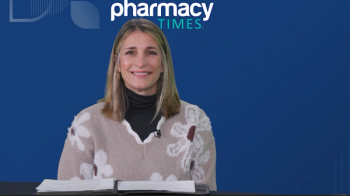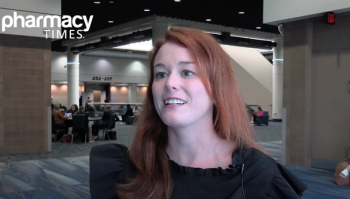
Christian Ruff explains the strong efficacy associated with abelacimab compared with rivaroxaban in the AZALEA-TIMI 71 trial.

Christian Ruff explains the strong efficacy associated with abelacimab compared with rivaroxaban in the AZALEA-TIMI 71 trial.

Panelists discuss how recent FDA regulatory actions regarding obeticholic acid have raised concerns about its long-term safety profile and accessibility, leading health care teams to develop strategies for supporting patients through treatment transitions while navigating insurance coverage and access challenges for newer primary biliary cholangitis (PBC) therapies.

Tocilizumab-anoh is expected to increase competition, improve patient access, and deliver cost savings in the treatment of various inflammatory conditions.

Three experts from UPMC Health Plan highlight the importance of treating patients’ physical, mental, and social health when managing diabetes, rather than the disease alone.

Naga Vara Kishore Pillarsetty, PhD, discusses advancements in radiopharmaceuticals for cancer therapy, noting common supply chain challenges, radiation safety measures, and patient misconceptions with the use of these drugs.

Panelists discuss how VMAT2 inhibitors' most commonly reported adverse effects include somnolence, fatigue, and mild parkinsonism symptoms, which can typically be managed through dose adjustments and careful titration strategies, while noting these side effects are generally less severe than those of older treatments and rarely lead to discontinuation when patients are properly monitored and educated about expectations.

Panelists discuss how long-term open-label extension studies of VMAT2 inhibitors demonstrated sustained efficacy and tolerability of both deutetrabenazine (ARM-TD and AIM-TD extensions showing durable response over 3 years) and valbenazine (KINECT 4 showing maintained improvements through 48 weeks), with low discontinuation rates due to adverse events and no new safety signals emerging during extended treatment periods.

Judith Alberto, MHA, RPh, BCOP, discusses the COA 2025 Community Oncology Conference, emphasizing its focus on transparency in oncology and the role of data in supporting pharmacists' contributions to patient care.

Melody Chang, RPh, MBA, BCOP, explains how American Oncology Network leveraged its experience with the Oncology Care Model to address challenges when adopting the Enhanced Oncology Model.

Panelists discuss how transitioning patients from obeticholic acid to seladelpar or elafibranor requires close monitoring of liver biochemistry, pruritus severity, medication adverse effects, and quality of life measures while providing clear patient education about expected timeline for symptom improvement and potential adjustment periods.

Panelists discuss how clinicians may transition patients to newer agents due to factors such as inadequate biochemical response, tolerability issues (particularly pruritus), or patient preference, while carefully considering the need for washout periods based on each drug's pharmacokinetics and mechanism of action.

Panelists discuss how VMAT2 inhibitors deutetrabenazine and valbenazine have revolutionized TD treatment through their proven efficacy in reducing involuntary movements and favorable safety profiles, with clinical trials demonstrating significant symptom improvement as measured by AIMS scores while maintaining psychiatric stability and showing key differences in dosing schedules and titration approaches.

Panelists discuss how comprehensive patient education about tardive dyskinesia risk factors, early warning signs, and available treatments is crucial for improving outcomes, while highlighting remaining unmet needs including better screening tools, enhanced provider training, expanded access to VMAT2 inhibitors, and more research into prevention strategies and novel therapeutic approaches.

Panelists discuss how long-term safety monitoring for second-line primary biliary cholangitis (PBC) therapies requires systematic assessment of liver function, lipid profiles, and potential drug-specific adverse effects while emerging 5-year safety data for seladelpar continues to demonstrate a favorable risk profile compared with other treatment options.

Panelists discuss how the safety profiles of second-line primary biliary cholangitis (PBC) therapies in compensated cirrhosis show varying levels of risk, with recent abstracts from EASL and AASLD 2024.

Panelists discuss how untreated tardive dyskinesia severely impacts patients' daily functioning and quality of life through physical limitations affecting basic tasks like eating and walking, social isolation due to visible symptoms, and heightened risks for older adults who face increased fall risks, difficulty maintaining independence, and complications from age-related comorbidities.

Panelists discuss how clinicians rely on careful observation, standardized rating scales like the AIMS (Abnormal Involuntary Movement Scale), and comprehensive patient histories to diagnose tardive dyskinesia, while facing challenges in distinguishing it from other movement disorders due to symptom overlap and the need to rule out conditions like drug-induced parkinsonism, akathisia, and primary movement disorders.

The California wildfires caused many medical and community challenges, including triaging services, addressing basic needs, and supporting displaced residents.

Farah Towfic, PharmD, MBA, RPh, explains the importance of USP's expert volunteer recruitment, particularly among pharmacists, to help create public quality standards, promote health literacy, and support initiatives, with applications open until March 13, 2025, for the next strategic cycle beginning July 1, 2025.

Christopher Herndon, PharmD, BCACP, FASHP, FCCP, CPE, discusses the upcoming BPS pain management certification launching in late 2025, its role in validating pharmacist expertise.

Pharmacies are actively working to address issues and support their patients by collaborative with regulatory bodies like the Board of Pharmacy, and their engagement with the local community.

Farah Towfic, PharmD, MBA, RPh, discusses how US Pharmacopeia helped to strengthen supply chain resilience in 2024 through data-driven insights, policy advocacy, and pharmacist engagement to address prolonged drug shortages, particularly for generic sterile injectables.

Pharmacists help patients manage allergies and asthma by identifying triggers, recommending appropriate treatments, ensuring proper medication usage, and finding affordable options.

Judith Alberto, MHA, RPh, BCOP, director of clinical initiatives at Community Oncology Alliance, discusses key policy issues affecting community oncology pharmacists in 2025.

Panelists discuss how managing primary biliary cholangitis (PBC) in women of childbearing age requires careful consideration of pregnancy risk categories for different medications, with UDCA being the safest option during pregnancy, while second-line therapies require strict contraception and careful monitoring of hormone interactions to ensure optimal safety and efficacy.

Panelists discuss how hepatotoxicity risks vary among second-line primary biliary cholangitis (PBC) treatments, with seladelpar and elafibranor showing favorable hepatic safety profiles compared to obeticholic acid, though all require regular liver function monitoring and dose adjustments based on individual patient response and disease severity.

The proposed age restrictions on dietary supplements would limit consumer access to safe products.

Panelists discuss how safety considerations for primary biliary cholangitis (PBC) treatment include monitoring liver function tests, managing pruritus and fatigue, assessing drug interactions, and evaluating individual patient factors like pregnancy status and comorbidities, which all influence the choice between ursodeoxycholic acid and second-line therapies.

Panelists discuss how sustained treatment success in primary biliary cholangitis (PBC) requires regular monitoring of biochemical response markers, assessing patient adherence, managing potential adverse effects, and making timely adjustments to treatment strategies based on individual patient responses to seladelpar and elafibranor.

New medications like glucagon-like peptide-1 agonists and resmetirom show promise in reversing fatty liver disease and preventing progression.